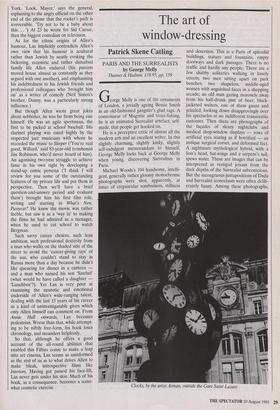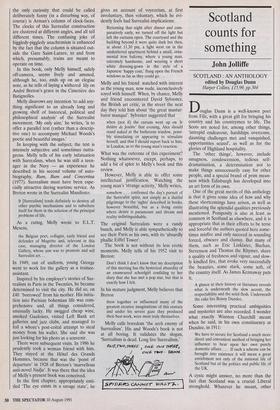The art of window-dressing
Patrick Skene Catling
PARIS AND THE SURREALISTS by George Melly Thames & Hudson, £18.95, pp. 159 George Melly is one of the ornaments of London, a jovially ageing Bessie Smith in an old-fashioned gangster's glad rags. A connoisseur of Magritte and trout-fishing, he is an animated Surrealist artefact, self- made, that people get hooked on.
He is a perceptive critic of almost all the modern arts and an excellent writer. In this slightly charming, slightly kinky, slightly self-indulgent memorandum to himself, George Melly looks back at George Melly when young, discovering Surrealism in Paris.
Michael Woods's 104 handsome, intelli- gent, generally rather gloomy monochrome photographs were shot, apparently, at times of crepuscular sombreness, stillness and desertion. This is a Paris of splendid buildings, statues and fountains, empty doorways and dark passages. There is no traffic and hardly any people. There are a few shabby solitaries walking in lonely streets; two men sitting apart on park benches; two shapeless, middle-aged women with anguished faces in a shopping arcade; an old man gazing morosely away from his half-drunk pint of beer; black- jacketed waiters, one of them gaunt and grizzled, looking down disapprovingly over his spectacles at an indifferent transvestite customer. Then there are photographs of the facades of sleazy nightclubs and medical shop-window displays — rows of artificial eyes staring as if horrified — an antique surgical corset, and deformed feet. A nightmare mythological hybrid, with a lion's head, bat-wings and a serpent's tail, spews water. These are images that can be interpreted as vestigial jetsam from the dark depths of the Surrealist subconscious. But the incongruous juxtapositions of Dada and Surrealist iconoclasm were often delib- erately funny. Among these photographs, Clocks, by the artist Arman, outside the Gare Suite-Lazare the only curiosity that could be called deliberately funny (in a disturbing way, of course) is Arman's column of clock-faces. The clocks of this Surrealist construction are clustered at different angles, and all tell different times. The confusing joke of higgledy-piggledy anachronism is enhanced by the fact that the column is situated out- side the Gare Saint-Lazare, to and from which, presumably, trains are meant to operate on time.
In this book, only Melly himself, safely off-camera, seems lively and amused, although he, too, ends up on an elegiac note, as he tells of laying a withered lily on Andre Breton's grave in the Cimetiere des Batignolles.
Melly disavows any intention 'to add any- thing significant to an already long and growing shelf of historical, political and philosophical analysis' of the Surrealist movement. 'My only aim,' he writes, 'is to offer a parallel text (rather than a descrip- tive one) to accompany Michael Woods's poetic and beautiful images.'
In keeping with the subject, the text is intensely subjective and sometimes outra- geous. Melly tells of his early infatuation with Surrealism, when he was still a teen- ager in the Navy — an experience he described in his second volume of auto- biography, Rum, Bum and Concertina (1977). Surrealism must have been espe- cially attractive during wartime service. As Breton wrote in the Surrealist Manifesto:
It [Surrealism] tends definitely to destroy all other psychic mechanisms and to substitute itself for them in the solution of the principal problems of life.
As a rating, Melly wrote to E.L.T. Mesens,
the Belgian poet, collagist, early friend and defender of Magritte and, relevant in this case, managing director of the London Gallery, whose aim was to promote and sell Surrealist art...
In 1949, out of uniform, young George went to work for the gallery as a trainee- assistant.
Inspired by his employer's stories of Sur- realism in Paris in the Twenties, he became determined to visit the city. He did so, on £40 'borrowed' from his mother. His initia- tion into Parisian bohemian life was com- prehensive and, all things considered, unusually lucky. He swigged cheap wine, smoked Gauloises, visited Left Bank art galleries and jazz clubs, and managed to foil a whore's post-coital attempt to steal money from his wallet. She said she was just looking for his photo as a souvenir.
There were subsequent visits. In 1986 he prudently took a woman friend with him. They stayed at the Hotel des Grands Hommes, because that was the 'point of departure' in 1928 of Breton's 'marvellous anti-novel Nadja'. It was there that the idea of Melly's present book was conceived.
In the first chapter, appropriately enti- tled 'The eye exists in a savage state', he
gives an account of voyeurism, at first involuntary, then voluntary, which he evi- dently feels had Surrealist implications:
Returning that night after dinner and com- paratively early, we turned off the light but left the curtains open. The courtyard and the building beyond it were quite dark but then, at about 11.30 pm, a light went on in the unshuttered apartment behind a small, orna- mental iron balcony, where a young man, extremely handsome, and wearing a short white dressing-gown in the style of a Japanese 'happy coat,' flung open the French windows as far as they could go...
Melly and his friend watched with interest as the young man, now nude, inconclusively toyed with himself. When, by chance, Melly and friend encountered David Sylvester, the British art critic, in the street the next day they told him about 'the great mastur- bator manqué'. Sylvester suggested that
when (not if) the curtain went up on `le theatre de fenetre' that evening, Alex should stand naked at the bathroom window, possi- bly stimulating or appearing to stimulate herself, and that I should report back to him, in London, as to the young man's reaction.
What was the outcome of this experiment? Nothing whatsoever, except, perhaps, to add a bit of spice to Melly's book and this review.
However, Melly is able to offer some intellectual justification. Watching the young man's 'strange activity,' Melly writes,
somehow . . . confirmed the day's pursuit of the Surrealist spirit, not simply as a dutiful pilgrimage to the 'sights' described in books, however beautiful, but as a living entity where desire is paramount and dream and reality indistinguishable.
The original Surrealists were a randy bunch, and Melly is able sympathetically to see their Paris as his own, with its 'absurdly phallic Eiffel Tower'.
The book is not without its less erotic moments. Melly tells of his 1952 visit to Breton:
Don't think I don't know that my description of this meeting has the hysterical absurdity of an enamoured schoolgirl confiding to her diary that she has met a pop star, but that is exactly how I felt.
In his mature judgment, Melly believes that Breton
drew together or influenced many of the greatest creative imaginations of this century and under his severe gaze they produced their best work, were most truly themselves.
Melly calls boredom 'the arch enemy of Surrealism'. His and Woods's book is not at all boring. It validates the slogan, `Surrealism is dead. Long live Surrealism.' 01,,,0,-rwajtoKEE r OM Two 7PREC, ONG riwo -• DAMN.



















































 Previous page
Previous page